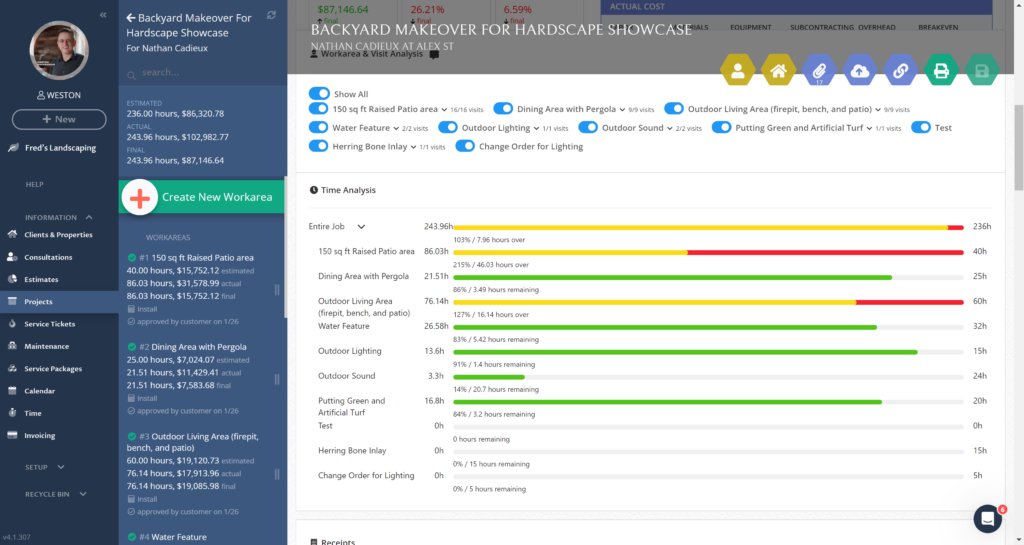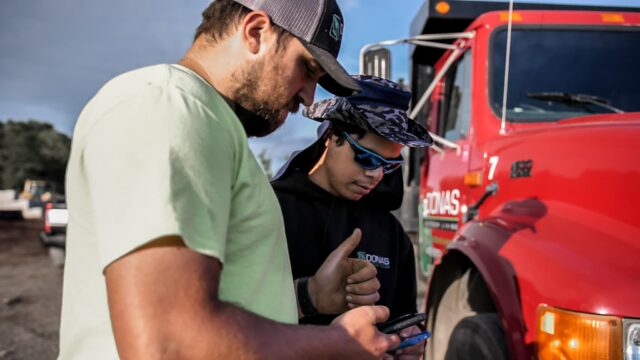Time tracking accurately and then allocating time to jobs can be a challenge for your crew. It takes leadership to embed diligent time tracking into your team culture.
But why should have time tracking to the point of allocating it to the job though? Why not just skip it?
(”I know what we worked anyway!”)
What’s wrong with my team just texting me their hours on Fridays?
Why not just use a time clock on the shop wall to mark when the employee arrived and left for the day?
Isn’t that good enough? Just need to know how many hours to run for payroll, right?
Well…
That is right, one function of time tracking is to accurately pay our people. Payroll.
But there’s another function.
One that is equally as important, maybe even more important.
Because if I don’t get this one right, it jeopardizes my ability to pay my team, or at minimum jeopardizes my ability to give them raises.
What is this other function of payroll?
Let me paint a time tracking scenario.
Let’s say you are time tracking on the time clock on the shop wall.
You are crushing it. Getting jobs done and cranking through your scheduled work that you sold.
You look up at the end of the season and check your bank account expecting to see a nice chunk of cash in there.
And you’re like “What!? 😱🥶
Where’s all my cash!?
We worked harder than we ever did before.
Processed more revenue than we ever did before.
Clients are happy, we have 5-star reviews galore.
Instagram loves our stuff.
But my bank account is feeling left out in the cold.
How am I going to make it through the winter on this?
This doesn’t make sense!
Ahem…. remember those time sheets from the time clock on the shop wall?
Those time sheets don’t signify what you were working on, they only signify that you were working.
The top reason for the problem scenario I painted out above is getting labor wrong in
- either your estimates. Not estimating enough labor when calculating your estimates.
- efficiency. It just straight is taking longer than it should.
You just don’t know it. And you don’t know which.
You might have a feeling where the issue is.
But gut feeling doesn’t count.
In God we trust. All others bring data.
Cold hard emotionless data is the only thing that can tell you the truth as to why that bank account isn’t keeping pace with all your hard work.
So, how do we get that data?
What good time tracking looks like
Time tracking is tied to the job, and the work area within the job.
ie Bob worked from 7 AM to 4 PM.
From 7 to 11 he worked on the patio work area. From 11 to 4 he worked in the landscaping work area.
With this level of detail, you can know exactly what took longer or less time than you had planned in your estimate.
Armed with that info, you have the power to run your business on data, not gut.
Strategically, not reactionarily.
When you run over hours on a job, the million-dollar question is “Well, why!? Where? What work area?”
When you can open up a job costing report and see exactly where you went right and where you went wrong you can do two things:
- Look at the estimated vs actual hours with your crew and ask them their opinion on the why for each work area that went over estimated hours. (As well as why for the workareas that were under estimated hours!)
- If you determine you simply didn’t figure enough hours in the original estimate, reality is it just takes longer than you had thought, then adjust your estimating to not repeat the same mistake on the next job.

Simplifying time tracking
So, revisiting the original problem, the original inspiration with which I sat down to write this article.
We’ve now painted the scenario that should have convinced you that you need to track your team’s labor to not only a job but also to a work area within that job.
So now it’s the “how do I go about it?”
And here’s where I want to share my tip of the day.
I ran a crew for many years at Tussey Landscaping, and we used the SynkedUP mobile app in time tracking not only to the job but also to the work area. Which gave us the real-time insights in the screenshot above.
Now we (the SynkedUP team) help contractors all over North America do the same thing.
A common friction point I’ve seen is their crew members feel overwhelmed by pulling out their phones to switch work areas on their timesheets as they work.
Meaning Bob starts working at 7 AM on the patio.
8:45 AM He suddenly needs to run some lighting wire for the lighting work area before he can continue working on the patio. So he spends 10 min running that wire.
Oh, wait! Pulls out the SynkedUP app, and switches work areas on his time sheets quickly.
10 min later he switches his timesheet back to the patio and resumes work.
It can feel tedious and overwhelming.
Switching work areas on your timesheet on your phone ten times a day is a bit much.
I agree.
A better way of time tracking
So, here’s what we did at Tussey Landscaping and it really worked well for us.
And that’s what I want to share with you today.
Instead of pulling my phone out 10 times a day to switch work areas on my timesheet as we worked, here’s what I did. (And what I recommend for simplifying time tracking)
At the beginning of the day when I got to the shop, I clocked into the job I was heading to.
I’d select the main work area that I was planning on working on that day.
I’d just stay clocked into that work area all day.
Then, in the truck on the way back to the shop, with my #2 right-hand crew member driving, me in the passenger seat, I’d pull out my phone open the SynkedUP app, and dial in my timesheets for the day.
I’d do a mental run-through of the day and be like:
“Ok, we spent about 2 hours on that work area, 15 min on that work area, and the rest of the hours on this work area.”
I’d then backdate the timesheets to reflect those totals.
My day’s time sheet’s start time was right, the end time was right, and the total hours per work area were right.
The only thing I sacrificed in this workflow is I couldn’t look at my timesheets to see every time I jumped from one work area to another for 10 min.
But does that really matter?
I only want the data to be able to make a better decision tomorrow. No analysis paralysis. KISS. Keep It Simple Stupid.
We found that the simplicity of that model was far easier for the crew, and still got us the tracking we needed to do accurate job costing and see estimated vs actual labor in each work area.
So there it is, that’s how we did it at Tussey Landscaping. It worked super well for us.
If you are a SynkedUP user and feel like you could use a Zoom call with your dedicated account rep to discuss best practices on this, pick a time for a call here.
If you are not a SynkedUP user and you’d like to see if you could use SynkedUP in your business to track time and avoid the “where’s my cash?” problem at the end of the year, pick a time for a call here, and we’ll explore your situation and potential solutions with you.
Until next time!
Happy Saturday!
Weston Zimmerman
co-founder and CEO of SynkedUP









